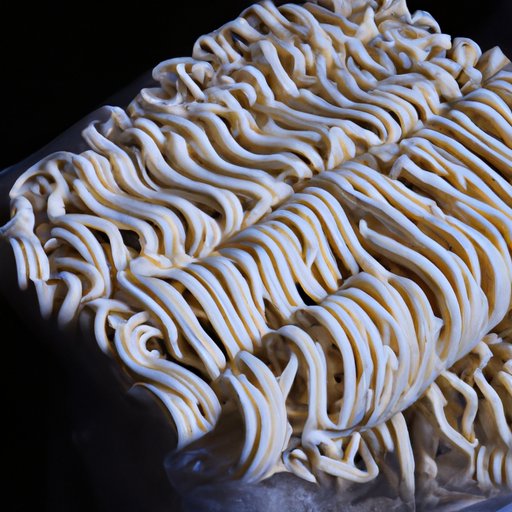Discover the Secrets to Making Perfect Noodles at Home
Do you find it challenging to make noodles that don’t turn out mushy or too chewy? Fear not, as this article will help you master the art of noodle making. Whether you’re a total beginner or just looking to up your noodle game, we’ve got you covered! Our comprehensive guide will take you through all the steps necessary to make homemade noodles that are sure to impress your family and friends.
Part 1: Step-by-step guide for making homemade noodles
Before we get started, let’s go over the ingredients you’ll need to make homemade noodles:
- All-purpose flour
- Water or eggs (depending on the recipe)
- Salt
- Cornstarch (optional, for dusting)
With your ingredients ready, let’s start making homemade noodles!
- Measure out the flour and salt and mix thoroughly in a mixing bowl.
- Gradually add in the water or eggs and mix until a stiff dough forms.
- Dust your working surface with a bit of cornstarch and knead the dough for 5-10 minutes until smooth and elastic.
- Cover the dough with a damp towel and let it rest for 30 minutes.
- Divide the dough into smaller portions and roll each one out into thin sheets.
- Cut the noodles into the desired shape and size.
- Boil a large pot of water with a pinch of salt, then add the noodles and stir occasionally. Cook for 3-5 minutes until the noodles are tender yet firm.
Pro tip: To prevent the noodles from sticking together, add a bit of oil or cornstarch to the cooking water.
Part 2: Comparative guide on different types of noodles
Gone are the days when spaghetti was the only type of noodle you could get your hands on. Nowadays, there are so many different types of noodles available in the market that it can be overwhelming to choose. Here’s a quick guide to help you differentiate between the most common types:
- Spaghetti: Thin, round noodles that pair well with tomato-based sauces.
- Fettuccine: Flat, ribbon-like noodles that go well with creamy sauces.
- Ramen: Thin, curly noodles that are most commonly used in broth-based soups.
- Soba: Thin, buckwheat noodles that are commonly served cold with dipping sauces.
- Rice noodles: Thin, translucent noodles made from rice flour that are commonly used in stir-fries and soups.
Each type of noodle has its own unique nutritional value, so it’s always a good idea to switch things up and try new types of noodles. Additionally, different sauces, broths, and meats pair well with different types of noodles, so don’t be afraid to experiment with your pairings.
Part 3: Tips and tricks for elevating plain noodles
If you’re looking to add flavor to plain noodles, there are many ways to do so. Here are some tips and tricks to elevate your noodle game:
- Add seasonings to the noodle dough: Try adding herbs, spices, or even garlic or ginger to your noodle dough for some added flavor.
- Increase the protein: Add shrimp, chicken, beef, or tofu to your noodle dishes to boost their nutritional value and taste.
- Sauce it up: Experiment with different sauces, from soy sauce to peanut sauce to sesame oil, to give your noodles flavor and depth.
Here’s an easy recipe for a flavorful noodle dish:
Spicy Garlic Noodles
Ingredients:
- 1 lb. spaghetti or other noodles
- 1/2 cup unsalted butter
- 1/4 cup olive oil
- 5 garlic cloves, minced
- 2 tsp. red chili flakes (more or less depending on your spice tolerance)
- Salt and pepper to taste
- 1/2 cup grated parmesan cheese(optional)
Instructions:
- Cook noodles according to package directions; drain and set aside.
- Heat butter and oil in a large skillet until butter has melted. Add garlic and red chili flakes, and saute until fragrant (around 1 minute). Season with salt and pepper as desired.
- Add the cooked noodles to the skillet and stir until fully coated with the sauce. Top with grated parmesan cheese for extra flavor.
Part 4: Fun and creative ways to enjoy noodles
Noodles don’t have to be relegated to just Asian-style dishes. Here are some non-traditional ways to enjoy noodles:
- Noodle salads: Use spaghetti or soba noodles as a base for a refreshing salad. Add in vegetables like cucumber, carrot, and bell peppers, and mix with a tangy vinaigrette for a flavorful meal.
- Noodle pizza toppings: Use cooked spaghetti or ramen noodles as a topping for a unique pizza crust. Add some tomato sauce, cheese, and your favorite toppings for a fun twist on pizza night.
- Noodle breakfast bowls: Swap out regular breakfast grains for rice noodles in a breakfast bowl. Pair with fresh ingredients like eggs, avocado, and bacon for a satisfying and healthy morning meal.
Part 5: Cultural and historical significance of noodles
Noodles have played a significant role in various cultures throughout history. Here are some fun facts about noodles:
- In China, noodles symbolize long life and are commonly eaten during special occasions like birthdays.
- Instant ramen was invented in Japan in 1958 by Momofuku Ando and has since become a staple food around the globe.
- Italians didn’t invent spaghetti carbonara, contrary to popular belief. The dish was actually created by US soldiers stationed in Italy during World War II.
- The most expensive noodle dish in the world can be found in Indonesia. A single plate of the dish, called Mie Tumpang, costs over $1000 USD.
Conclusion
Whether you’re looking to make homemade noodles for the first time or just looking for ways to elevate your noodle game, this article has provided you with all the necessary information to do so. From step-by-step guides to comparative charts and flavor-boosting tips, you’re sure to impress your family and friends with delicious, homemade noodles.
